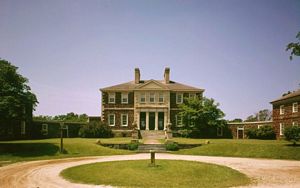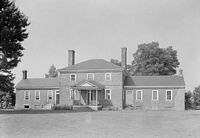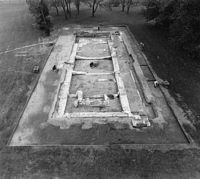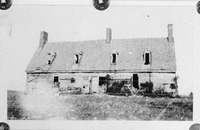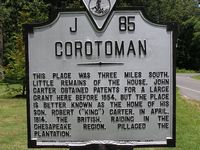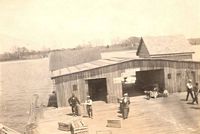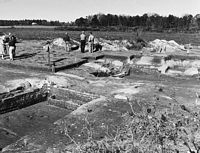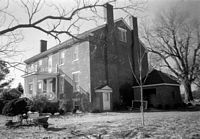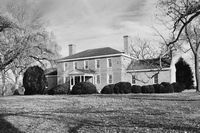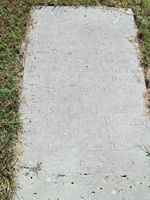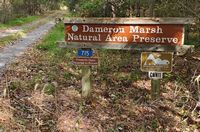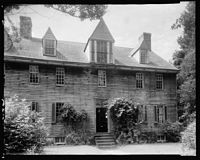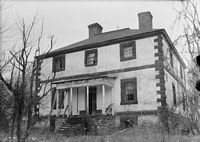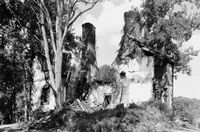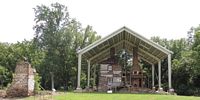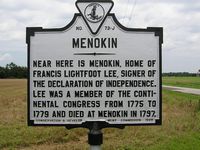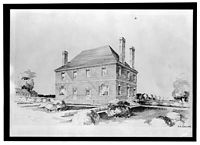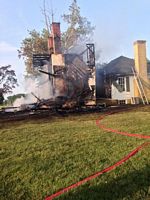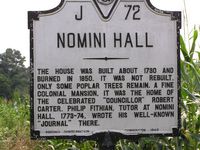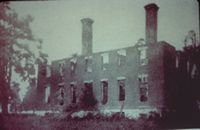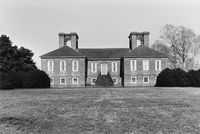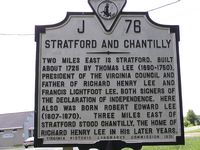Plantations of the Northern Neck
The following selection is only a sample of the many large and historic properties on the Northern Neck. Well known examples have been selected from each county as well as other properties that have a Dameron/George family connection. Many of these homes have been lost over the years, mostly to fire, but several still stand and function as private homes or public museums.
Lancaster County
- Belle Isle
Built about 1759 by either the Burwell of Downman family. Is now part of Belle Isle State Park and listed on the National Register of Historic Places. - Corotoman
Built in the early 1720's by Robert "King" Carter. King Carter amassed over 200,000 acres of land in Virginia during his life. The home was burnt in 1729, but a supporting structure from the estate known as the "Spinster's House" stood until the 1930s. Modern archaeological excavations revealed the home was 40x90 feet, had a center hall tiled with marble and a marble trimmed fireplace. The site is under the jurisdiction of Preservation Virginia and listed on the National Register of Historic places. - Enon Hall
The Enon Hall estate is located on the headwaters of Antipoison Creek. It was established by the Hathaway family, the original part of the house is thought to have been built before 1700. For a time in the 1950s the home was owned by Elton Dameron. The home has now returned to the Hathaway's and recently undergone major restoration work. - Monaskon
The Monaskon Plantation was first mentioned in the 1702 will of David Fox, Jr.. A post office was established there in 1860 and Monaskon Wharf became a regular steamboat stop in the late 1800's. For a time the property was farmed by the Landreth Seed Company. From the late 1970s to the early 2000s Monaskon was owned by Ralph Dameron. - Millenbeck
Millenbeck purchased by William Ball, great-grandfather of George Washington in 1680, and was the seat of the Ball family for over 100 years. Archaeological excavations at the site found evidence of the home and of a nearby fort built during the time of Bacon's Rebellion. Listed on the Virginia Landmarks Register.
Northumberland County
- Clifton
Clifton was built about 1785 by Landon Carter, Jr., grandson of Landon Carter of Sabine Hall and great-grandson of King Carter. The home was originally thought to have been built as a hunting lodge. Listed on the Virginia Landmarks Register and the National Register of Historic Places. - Cobb's Hall
Cobb's Hall sits on land patented by in 1651 by Col. Richard Lee, the progenitor of the Lee family in Virginia. The property passed to his son Charles Lee. The current home was built in the mid-1850s by Lewis and Martha (Lee) Harvey. Listed on the Virginia Landmarks Register and the National Register of Historic Places. - Ditchley
Ditchley was built about 1762 by Kendall Lee. The home sits on the same 1651 Lee family land patent as nearby Cobb's Hall. The estate was sold to the Ball family in 1792 and in 1932 came into the possession of Jessie Ball DuPont and now belongs to the foundation named in her honor. The tombstone of Richard Lee's son, Hancock Lee is located across the road from Ditchley, bearing the dates 1653-1709. Listed on the Virginia Landmarks Register and the National Register of Historic Places. - Edge Hill
Edge Hill sits on the bluffs of the Great Wicomico river across from Glebe Point. The home was built about 1835 by Dr. Hiram William Harding. Recently it was moved inland from it's original foundation. - Guarding Point
Guarding Point was likely built before the Civil War by the Harding family. The home sets on land purchased by Lawrence Dameron in 1655 and held in the Dameron family for over 200 years. The property was also known as Garden Point and Dameron Marsh. A home known as Gascony borders the property and is said to have been burnt by the British during the Revolution, it also came into the possession of the Harding family and was rebuilt in 1848. Dameron Marsh is now a 316 acre Natural Area Preserve.
Richmond County
- Bladensfield
Bladensfield was built about 1790 by Robert "Counciller" Carter of Nomini Hall for one of his daughters. In 1854 Rev. William N. Ward built an addition on the home to create a girl's seminary. Previously listed on the Virginia Landmarks Register and the National Register of Historic Places until it's destruction by fire in 1996. - Edge Hill
Edge Hill was a large brick home built in 1770 by John Chinn. In the 1930s the home was torn down by Chinn family descendants and the bricks were taken to Tappahannock and Richmond City to build other homes. - Menokin
Menokin was completed about 1775 and was a wedding gift from John Tayloe II to his daughter Rebbecca and her husband Francis Lightfoot Lee, signer of the Declaration of Independence. The home was small in size but very formally built and stood on 1,000 acres. By 1940 the house was abandoned and it deteriorated badly until 1995 when it came under the ownership of the Menokin Foundation for architectural conservation and archaeological study. Now the ruins are being preserved under a large metal shed and encased in glass. The site is open to the public and has been designated a National Historic Landmark as well as being included on the Virginia Landmarks Register and the National Register of Historic Places. - Mount Airy
Mount Airy sits on land acquired by the Tayloe family in 1682. The home was built in 1753 by John Tayloe II with locally mined sandstone walls that are three feet thick. A 18th century stable still stands on the property. A grinding mill known as Tayloe's Mill operated on the property from 1724 to 1968, Samuel R. Franklin lived in the vicinity of the mill. Members of the Tayloe family still live in Mount Airy. It has been designated a National Historic Landmark and listed on the Virginia Landmarks Register and the National Register of Historic Places. - Sabine Hall
Sabine Hall was built about 1738 by Landon Carter, son of Robert "King" Carter. It is still owned by descendants of the Carter family today. A National Historic Landmark and listed on the Virginia Landmarks Register and the National Register of Historic Places.
Westmoreland County
- Burnt House Field
Was the site of Machodoc, the first house on lands patented by Richard Lee the immigrant. Machodoc burnt down in 1729 and only a family burial plot remains. Thomas Lee, builder of Stratford Hall and Richard Henry Lee, signer of the Leedstown Resolves are buried here. - Lee Hall
Lee Hall was a large brick house built in 1720 by Thomas Lee for his brother, Henry Lee. While teaching at Nomini Hall Philip Vickers Fithian wrote about an extravagant three-day ball held there. The exact site of the home has been lost - Nomini Hall
Nomini Hall was built about 1730 by Robert "King" Carter for his son, Robert Carter II and inherited by Robert "Councillor" Carter III. The home burned down about 1850 and another small house also named Nomini Hall was built near the site, this home also burned in 2014. - Peckatone
Peckatone plantation was named after the local Indian Chief in 1650 when the land was patented. The mansion house was built by Gawen Corbin in 1750. After the Civil War the house was sold out of the family and acquired by Samuel Redman Hardwick. After his death the house was sold and soon after burned down. The site of the home has now eroded into the Potomac. - Stratford Hall
Stratford was built in the 1730s by Thomas Lee. The plantation grew to contain 6,600 acres before being sold from the Lee family in 1822. In 1929 the property was acquired by the Robert E. Lee Memorial Association. The home and many surviving outbuildings are open to the public. Listed as a National Historic Landmark and on the Virginia Landmarks Register and National Register of Historic Places.
Map:

Sources:

- Wolf, Thomas A. Historic Sites in Virginia's Northern Neck and Essex County: A Guide. Warsaw, Va: Preservation Virginia, Northern Neck Branch, 2011. Print.
Last Updated: 9/21/221



